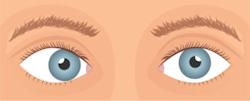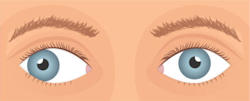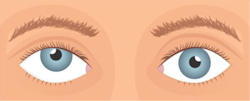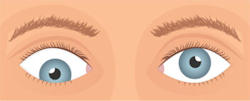
What is Strabismus and what are its types?
Strabismus refers to the condition where both eyes cannot focus on the same point. Strabismus can occur inward, outward, upward, or downward. Approximately 5% of the population experiences strabismus.
It can lead to headaches, double vision, lazy eye (reduced vision), decreased self-esteem, impaired depth perception, eye fatigue, and fatigue.
It can be present from birth or develop later in life.
Strabismus can occur when looking in all gaze positions or only in certain directions. In such cases, for example, a person who can align their eyes when looking straight ahead may develop strabismus when looking to the side, upward, downward, or obliquely. Sometimes, the same eye may drift consistently, while other times, drifting may occur alternately in the right and left eyes.
Strabismus can lead to head positions such as turning the face to one side to look straight ahead or tilting the head to the side to look straight ahead.




What is Pseudo-Strabismus?
Pseudo-strabismus can occur when both eyes are looking at the same point but appear to have strabismus. In many children, the root of the nose is wide, so during side glances, the eye behind may appear to deviate inward, giving a false appearance of strabismus. It does not require treatment and usually improves with age.Sometimes, the structural axis of the eye may be significantly different from the visual axis. This also gives a false appearance of strabismus.
What are the causes of strabismus?
There are many causes of strabismus. The main ones include: the development of accommodative strabismus, especially in hyperopic individuals, strabismus due to decreased vision in one eye, paralysis of the eye nerves, thyroid disorders, myasthenia gravis, genetic and congenital causes, muscle or sheath stiffness, and trauma. Another strabismus case has been seen in 30% of families where strabismus is present.Strabismus in children
Strabismus can occur in children from birth or develop later in life.The brain merges the images coming from both eyes to create three-dimensional, depth perception. When strabismus occurs, the brain cannot merge the two images. To prevent double vision, the brain suppresses one of the images. Therefore, if treatment for strabismus in children is delayed, lazy eye (amblyopia) may develop in one eye, and the child may see one eye weakly for life. If treatment is delayed again, three-dimensional vision may not be regained, and difficulties may arise in perceiving distance and performing fine tasks. Children experiencing this may also have difficulty calculating the approach distance of cars in traffic and performing fine motor skills in adulthood.
In children with strabismus, treatments such as glasses therapy, lazy eye therapy with methods such as patching one eye, surgical treatment, or combinations of these methods may be applied.
Electronic glasses powered by batteries have been developed to facilitate patching therapy. Electronic applications such as Dichoptic treatment in lazy eye therapy, which is the most recent approach, and citicoline drug therapy may be used.
Strabismus in adults
Strabismus in adults can result from untreated or unsuccessfully treated childhood strabismus persisting into adulthood, as well as from conditions such as nerve paralysis affecting the eyes, lazy eye, thyroid disorders, myasthenia gravis, other neurological disorders, trauma, or certain diseases.Late-onset deviations in adulthood often lead to double vision.
Following surgical treatment for adult strabismus, double vision (diplopia) may occur, which can persist longer in adults compared to children, and may even be constant. In such cases, prism glasses or repeat surgical intervention may be necessary. Adjustable suture surgery in individuals over 15 years old provides more precise results in aligning the eyes and reduces the likelihood of double vision.
After adult strabismus surgery, the restoration of depth perception is sometimes possible. Improved strabismus can enhance the self-confidence of the individual, leading to a happier life.
What are the treatments for strabismus?
Some cases of strabismus can be completely corrected with glasses, contact lenses, or excimer laser treatment. Some cases of strabismus may only partially improve with these treatments. Some cases of strabismus may benefit from orthoptic therapy.- Prismatic glasses may be given in some cases of strabismus. Botulinum toxin (such as Botox) may be applied in some cases of strabismus.
- Most cases of strabismus require surgery. The muscles that move the eye are strengthened, relaxed, or repositioned.
- Multiple surgeries may be required for strabismus treatment.
- Before strabismus surgery, treatment may be necessary for lazy eye (amblyopia).
- After surgery, especially in adult patients, double vision (diplopia) may occur. If double vision occurs, prismatic glasses or repeat surgery may be necessary. Undergoing surgery at an early age reduces the likelihood of double vision.
- It is very rare for vision loss to occur after strabismus surgery. Early surgery is crucial.

When should strabismus be treated?
For congenital esotropia, the ideal age for surgery is between 6 to 12 months.For strabismus that appears during infancy or childhood, the ideal age for surgery is before 4 years old. However, this is not always possible due to delayed intervention by the family.
For intermittent strabismus, surgery is suitable once accurate measurements have been obtained.
In surgeries performed at an early age, it is more likely to regain depth perception and achieve optimal visual function. As the surgery for strabismus is delayed, the likelihood of acquiring depth perception decreases while the probability of double vision increases.
As adults age, adjustable suture surgery reduces the risk of double vision complications.
What are the benefits of strabismus treatment?
- Depth perception can be achieved with strabismus treatment if the eyes can focus on the same point.
- Improvement in strabismus enhances a person's self-confidence and social skills.
- In early treatments, the likelihood of lazy eye (amblyopia) is reduced, and lazy eye treatment may partially or completely improve when added to treatment.
- Early strabismus treatment reduces the likelihood of double vision. The likelihood of double vision increases in adulthood.
- If depth perception is achieved, the likelihood of accidents in traffic decreases, and fine motor skills improve.
What are the strabismus treatments performed at SEVGİGÖZ?
- Surgeries are performed in our clinic for inward, outward, upward, downward, and oblique strabismus, as well as for patients who have undergone various surgeries multiple times,
- Special cases such as Brown Syndrome, Duane Syndrome, cases with various movement limitations,
- Patients with developed head positions where they turn their face to the right or left or tilt their head to the side due to strabismus or nystagmus,
- Patients ranging from 6 months to their seventies
- Adjustable suture surgery is performed for adult strabismus cases to reduce the possibility of double vision after surgery and to increase the likelihood of achieving smoother alignment.
- Nystagmus (eye tremor) surgery is performed.
- Botulinum toxin (Botox) injections can be administered to cases where necessary.
- The most current approach in amblyopia (lazy eye) treatment is Dichoptic treatment. It is a computer-assisted and three-dimensional treatment that stimulates both eyes and has been applied in recent years. It can be effective even after the age of 10 in suitable cases. Its biggest advantages are enhancing three-dimensional vision and being more easily applicable to children who do not comply with patching therapy. Generally, the higher the initial level of vision, the greater the gain. It is also used in scientific studies for children in the patching age group and those with low visual acuity. It is applied in our clinic.




